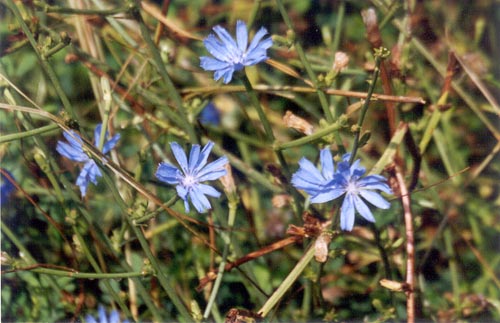Relatives
Cichorium intybus L. - Common or root chicory.
Taxonomic position.
Family: Asteraceae Dumort.; genus: Carthamus L.Morphology and biology.
Perennial plant 40-80 cm in height with a thick taproot. Stem is straight and branchy in the lower part, either bare or with straight hairs. Root leaves are usually pinnately parted; lower stem leaves are ovate, amplexicaul, up to 10 cm in length, about 5 cm in width, with rare unequal denticles along the edges. Inflorescences are anthodia, usually numerous, minute, sessile on the top of the stem and on lateral branches; in upper axils, the leaves are very diminished. Involucel are 10-15 mm in length, 4-5 mm in width, glandular-haired, distichous; their outer leaflets are 1.5 times shorter than the inner ones. Flowers are blue or dark blue, rarely whitish in color. Achenes are 2-3 mm in length, oblong, with pappus on their tops. Blossoms in July-August; bears fruit in September-October. Entomophilous. Zoochore.Distribution.
General distribution area includes almost all of Europe, Northern Africa, Anterior Asia, and Iran. As an invasive plant, it occurs in Southern Africa, South and North America, Australia, and the western provinces of China. Within the former USSR, this plant occurs throughout the Europaean region, except in the north (Karelsko-Laplandsky, Dvinsko-Pechorsky), where it occurs very rarely as an invasive plant; the Caucasus; Central Asia; Southwestern Siberia; and Southeastern Siberia.Ecology.
Occurs in n meadows, along roads, in fields, and near residential areas. It grows in areas as high as the middle mountain belt.Utilization and economic value.
Roots are used as a coffee surrogate and can be utilized in sugar and alcohol production. Leaves are used for salad. Roots are utilized in medicine for preparing digestive stimulants. Good honey plant.References:
Cherepanov, S.K. 1995. Plantae Vasculares Rossicae et Civitatum Collimitanearum (in limicis USSR olim). St-Petersburg, "Mir I Semia", 990 p. (in Russian).Hulten E., Fries M. 1986. Atlas of northern European vascular plants north of the Tropic of Cancer. Konigstein. V. 1-3. 1172 p.
Krasnoborov I.M., ed. 1997. Flora of the Siberia. Vol. 4. Novosibirsk: Nauka, p. 140-141.
Malyshev L.I., Peshkova G.A., eds. 1979. Flora of the Central Siberia. Vol. II. Novosibirsk: Nauka, p. 893.
Shmidt V.M., ed. 1990. Areas of medicinal and related it plants of the USSR: An Atlas. Leningrad: LGU. P. 80-81, 211.
Tsvelev N.N., ed. 1964. Flora of the USSR. Vol. 29. M.-L.: Publishing House of Acad. Science, pp. 16-17. (in Russian).
Tsvelev N.N. 2000. Manual of the vascular plants of Northwestern Russia (Leningrad, Pskov and Novgorod district). St. Petersburg, Publishing House of SPHFA, p. 511. (in Russian).


